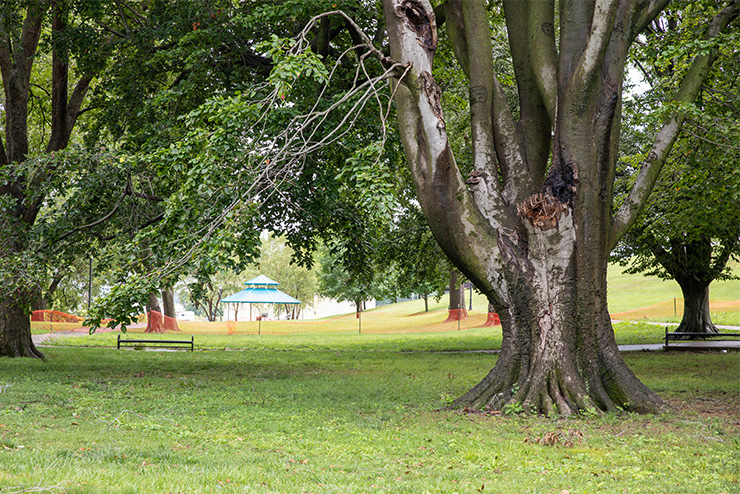A state champion beech tree on Southeast Missouri State University’s River Campus will be removed early next week after approximately 200 years of standing.
“I do not want people to feel we made this decision lightly,” said Southeast President Dr. Carlos Vargas. “We have spent 11 months consulting with experts and exploring options before reaching this decision.”
Assessing Health
It began in August 2022 when a large limb fell from the base of the tree due to rotting in the main trunk caused by age. The branch, multiple feet in diameter, was one of the main structural branches and reached a walking path on the River Campus when it fell.
After that, University officials had the tree’s health and stability evaluated by three private arborists and experts, a community forester with the Missouri Department of Conservation, and a forestry entomologist with the Department of Conservation. The assessments were all similar.
 “The tree’s heartwood is what provides the structural integrity,” says Jennifer Behnken, community forester with the Missouri Department of Conservation’s southeast region. “There’s no central stem on this beech, so the branches create a cup that collects moisture. For decades, that’s contributed to the decay in the central heartwood of the tree. We can also see in places where sections of some of the larger branches are hollowed out.”
“The tree’s heartwood is what provides the structural integrity,” says Jennifer Behnken, community forester with the Missouri Department of Conservation’s southeast region. “There’s no central stem on this beech, so the branches create a cup that collects moisture. For decades, that’s contributed to the decay in the central heartwood of the tree. We can also see in places where sections of some of the larger branches are hollowed out.”
To assess the tree’s structural integrity, an arborist performed a sonic tomography test that takes the length of time soundwaves travel from sensors placed on the tree to determine where there is decayed and non-decayed wood. Software then determines how much of a loss in load carrying capacity has been caused by the decayed wood. The results found extensive internal decay.
In addition, experts also discovered Kretzchmaria duesta around the base. Kretzchmaria is a fungus that attacks a tree’s root system, causing further instability.
“It’s a common pathogen that beeches are particularly prone to,” said Robbie Doerhoff, a Missouri Department of Conservation forest entomologist. “There is no treatment for it.”
A resistance drill test was performed at five locations on the tree, and Chris Rippey, with Missouri Arborist Company says at all sites, decayed wood was found in the roots.
“The amount of root decay found in this area is extensive, and it is unknown precisely how much the non-visible/untested roots are decayed, but based on the location of the decay in the visible root, I suspect it to be considerable,” wrote Rippey.
The decay in the branches combined with the rot at the roots caused by the fungus had to be weighed with the emotional attachment to the tree and, most importantly, the safety of the public.
“This tree has stood above the banks of the Mississippi before there was ever a Southeast Missouri State,” said Dr. Vargas. “I understand the importance and the history of that. These have been difficult deliberations for all of us at SEMO because we each respect and value what the state champion Beech tree brings to the grounds. But, ultimately, our priority is the safety of students and the public who visit our campus.”
Behnken concurred, “Trees are organisms and they have life expectancies. Sometimes you do everything right and it’s still the unfortunate outcome. In this case, the wind event and the design of the tree contributed to what’s been in motion for a long time. Now, it really comes down to public safety. Given the location of where it is, these factors are a game changer for making this ultimate decision."
Staring up at the tree, Doerhoff said, “Thousands of pounds are hanging in the air. This branch is more of a ticking time bomb. It has large wounds [from carving and losing branches] that it won’t heal from. Wounds on the tree make it more susceptible to infestations and disease pathogens, which compromises the tree’s health, especially under stress. There is definitely an emotional aspect to the decision, but the situation is what is dictating the removal of this tree.”
Honoring the Legacy
While saying goodbye isn’t easy, the Crisp Museum at the River Campus has plans to commemorate what the tree brought to campus. The Museum is hosting a Family Day at the Museum on Saturday, July 29 from 11 a.m. to 1:30 p.m. The event is open to the public and will include an exhibit dedicated to the tree and activities for kids to celebrate the tree. Visit rivercampus.org for more information.
The History
The tree’s state champion status officially commemorating it as the largest known of its species in the state of Missouri was awarded in 1996, before Southeast owned the property. The Department of Conservation’s former community forester Rocky Hayes was contacted by a nonprofit community organization involved with the property at that time to take a look. Hayes measured the tree at 88 feet tall at the time and submitted to the state. The plaque designating the tree as the state champion hung in Hayes’ office until his retirement.
The American beech, Fagus grandifolia, is the only native North American species of beech tree. The state champion tree is 209 inches (17 feet) in circumference, 109 feet tall, 97 feet in spread, and is about 200 years old.
Two smaller beech trees live in the shadow of the state champion on the River Campus grounds. Behnken guesses they may be children of the champion tree. Southeast has consulted with the Department of Conservation on additional measures to care for the progeny to preserve its legacy.